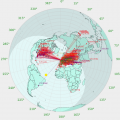G8JNJ
About
- Username
- G8JNJ
- Joined
- Visits
- 4,628
- Last Active
- Roles
- Member
- Points
- 127
Reactions
-
OpenWebRX [using a transverter/down-converter with the Kiwi]
Hi Lonecrow,
OK that's good so it doesn't look like anything major is broken.
I'd suggest that as you are making a lot of changes to the config, it may be a good idea to buy a few decent quality SD cards so that you can backup an image of the whole KiWi and then you can recover, or at least quickly get back to a known good state without any hassle.
I'd save the current config to a new card and then load up the original config from the SD that came with the KiWi and update it to the latest version and then do all the basic setup so that you have a working KiWi. Then save that version to another new SD card.
You then have the original SD card supplied with the KiWi (get out of jail), a working basic recent config (gets you quickly to a good starting point for anything else on another card, and finally another with your most recent VHF config.
Yet another card would allow you to backup your most recent working version, so you can very quickly get back to where you were, if you do accidentally mess something up. You can then rotate the two VHF SD cards so that you are only a few steps behind if things go wrong.
I'm not a proficient coder, but I do mess around with my KiWi's from time to time and having a few backups on SD has saved me big time on more than one occasion when I thought I'd bricked the KiWi.
Regards,
Martin - G8JNJ -
OpenWebRX [using a transverter/down-converter with the Kiwi]
Hi Lonecrow,
If they are fairly short patch cables it won't make much practical difference. Ideally you would use the correct impedance throughout, but it's less critical for receive only purposes.
Note that frequencies on the airband commonly have off-sets to accommodate 8.66KHz channel spacing within 5KHz frequency steps supported by older aircraft radios and also to allow multicasting from several sites on the same frequency (typically for wide area stuff like Volmet).
Aircraft and some ground based transmissions (typically at smaller or grass strip airfields) also have slight frequency errors that can often be observed on spot frequencies.
Regards,
Martin - G8JNJ -
OpenWebRX [using a transverter/down-converter with the Kiwi]
Hi Lonecrow,
Yes you can use the airband and FM band filters together, if the airband filter is good enough you may not need the FM band notch.
I think the reason you don't see it with the dongle and SDR Sharp may be an issue with the KiWi that you probably wouldn't otherwise notice, but this is what I'd hope to test.
To get the frequency off-set correct you may need to either adjust the transvertor reference frequency and / or the KiWi Frequency scale offset (kHz) value.
Regards,
Martin - G8JNJ -
OpenWebRX [using a transverter/down-converter with the Kiwi]
Hi Lonecrow,
I think the problem could be a very strong out of band VHF Digital TV signal that is being down-converted to a frequency that is being aliased by the KiWi to the frequency range you are seeing.
The reason for trying the Airband filter is to see if it reduces the unwanted signal that may not be suppressed sufficiently by the transvertor's built in filters.
The 30MHz low pass filter will help test to see if the problem is the down-converted un-signal that is being aliased by the KiWi sampling frequency from somewhere around 70MHz to 18MHz.
As I say, it is only a theory at the moment.
Regards,
Martin - G8JNJ -
OpenWebRX [using a transverter/down-converter with the Kiwi]
Hi Lonecrow,
Looking at the spectrum and using the new peak hold function, the noise has a fairly well defined 'shape' that could possibly be a VHF Digital TV transmission using the ATSC standard.
I have a theory about how this could be occurring, but a bit of testing is required to prove it.
First - does the noise go away when you disconnect the Air Band antenna ?
If it does then try.
1. Adding an aircraft band Band Pass Filter to the input of the transvertor.
Something like the "bandpass filter BPF 118-136MHz for Air band" that are sold on Ebay.
2. Adding a 30MHz low pass filter between the transvertor and the KiWi.
Something like the "ZETAGI F27 FILTER ANTI TVI FREQUENCY 0-30 MHZ 300W" or some other CB TVI filter as sold on Ebay
Do either (or both) of these things appreciably reduce the level of the interference ?
Regards,
Martin - G8JNJ -
Last Spectrum persists when all signals removed [fixed in v1.279]
-
Denoiser and Autonotch tick boxes not working on main audio control panel [fixed in v1.278]
-
Any Ideas [AM BCB overload]
Some of the 5GHz link kit I've had problems with in the past used Power Over Ethernet which was very noisy. In fact any POE kit seems to generate a lot of unwanted noise. This is a major issue with my Kernow KiWi http://kernow.hopto.org:8073/ which is currently using a temporary active monopole mounted above a room containing POE kit.
Also some of the Bias Tees that are used with Mini Whips don't have adequate filtering on the DC path, so any noise picked up from the power supply or DC connecting cable gets transferred directly onto the RF path and into the receiver.
However Mini-Whips and other E-Probe antennas tend to be noise magnets due to their unbalanced design and high value of feed point impedance, which makes it very difficult to choke off or completely eradicate noise that is picked up on the feed cable. Balanced active antennas and active loops (which have a much lower value of feed point impedance) are much better in this respect.
Regards,
Martin - G8JNJ -
GPS Problems
Does the KiWI GPS antenna work OK with your other GPS receiver ?
Is the KiWi GPS antenna placed on a metal surface ? This helps because the antenna was designed to sit on a motor vehicle roof which acts as a ground plane / reflector. It doesn't work as well if there is no metal surface below it.
When mounted outside in the clear and on a metal surface the GPS antenna and KiWi receiver can work quite well.
Regards,
Martin - G8JNJ -
On-Line frequency database
Copied from UDXF@groups.io
"You may or may not be aware that the ITU monitoring stations publish their
listening logs on their public website:
https://www.itu.int/en/ITU-R/terrestrial/monitoring/Pages/Regular.aspx
This page describes the purpose of the monitoring activity as well as
allowing you to download the logs as Excel spreadsheets; there's also a
search tool so you can search for logs by frequency and date.
The spreadsheets often include DF bearings with an accuracy indication and
signal strength as well as time, frequency, mode, comments etc.
They often mention the kind of things we like listening to!"
I've previously taken a look at the ITU loggings but they always tended to be a bit of a pin to trawl through.
However the new database search tool is very good. Especially if you are careful about what search parameters you set. You can then click on a individual log entry for even more detail.
It would be even better if you could download the searched results, but maybe someone will get around to writing a scraper tool :-)
Regards,
Martin - G8JNJ







